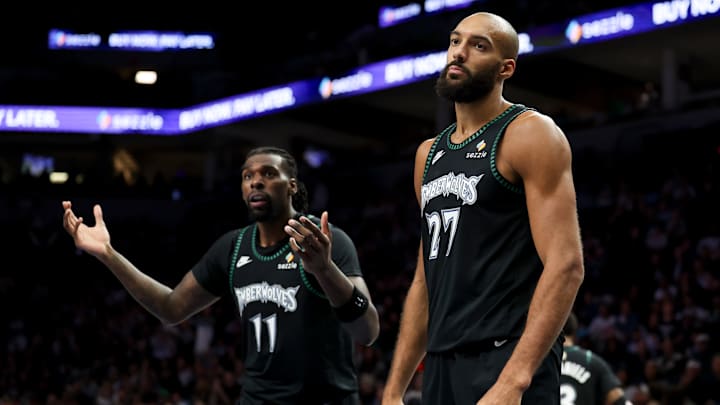Amid a 10-7 start to the season, and back-to-back late-game collapses, there is plenty of confusion around the Minnesota Timberwolves. Likewise, I don't think there's not a more confusing player on the Timberwolves (and perhaps even the league) than Rudy Gobert. That's not to say he's a bad player, by any means, but rather the difference between his defense and offense is one of the widest gaps in the league.
With Rudy on the court, Minnesota's defense is elite; in fact, their 106.1 defensive rating (per Cleaning the Glass) with Gobert translates to the second-best DRTG in the league. However, with Gobert off the court, the Wolves have a 128.3 DRTG, which translates to dead last in the league. Overall, Gobert's minus-22.2 on/off defensive swing ranks in the 99th percentile; Neemias Queta is the only player with a more significant swing.
Offensively, it's the opposite story, though. Gobert minus-9.4 on/off swing ranks in the 8th percentile. With Gobert off the court, Minnesota has a 125.6 offensive rating, which translates to the best mark in the league. When Gobert is on the court, the Wolves have a 116.2 offensive rating, which translates to the 16th-best offense in the league. Ok, I'll admit this isn't as significant as his defensive on/swing, but it's still telling.
Gobert's elite defense and subpar offense put the Wolves in an impossible spot.
Gobert's defense is essential to the Wolves' success
It's confusing that a player can be so valuable on one end of the court and so harmful on the other end of the court, but that's exactly the case with Gobert. The Wolves need Gobert to have an elite defense, which has been their identity since trading for him in 2022.
For a while, it looked like pairing Jaylen Clark and Jaden McDaniels was a solution to the non-Rudy minutes. However, this lineup's DRTG has declined to 119.7 (one week ago, it was 114.7), and it has also been deployed less in recent games. The Wolves don't have a true rotational center without Gobert. Julius Randle and Naz Reid are fantastic offensive players, but neither can anchor a defense.
Remarkably, Gobert is holding opponents to 38.3 percent within six feet of the hoop; the league average is 58.8 percent. Gobert's presence at the rim erases any mistakes made on the perimeter. He is also more switchable than he gets credit for. Yes, Gobert isn't like Bam Adebayo or Victor Wembanyama in this sense, but his versatility is underrated.
Gobert is limited offensively
Despite his incredible defense, Gobert's offense is problematic. In theory, 10.7 points on 73.3 percent shooting isn't terrible. However, Gobert has poor hands, and opposing defenses don't respect him. Unless it's a wide-open dunk, Gobert isn't a very consistent scorer. Notably, he averages 1.9 turnovers per game.
It is important to acknowledge that the reason why opponents blitz Anthony Edwards so frequently is because of Rudy Gobert's offensive shortcomings.
— Jonah (@Huncho_Jman) November 15, 2025
However, it sure would be nice if 27 were more reliable here. pic.twitter.com/2UfLsJIQ2r
Now the Wolves have proven they can have a stellar offense with Gobert on the court. In fact, the Wolves' starting lineup has a 122.3 ORTG. Nevertheless, clutch time games have been the real issue for the Wolves. Minnesota ranks 26th in clutch time offense. Gobert is far from the Wolves' main problem, but he's a factor.
Anthony Edwards gets blitzed and pressured on nearly every possession. Sure, you could argue that this is due to Edwards still not being a great playmaker. That's certainly a factor, but defenses not taking Gobert seriously allows them to pressure Ant more.
This is a problem throughout the game, but especially in late-game situations. You can't pull Gobert from the closing lineup due to his elite defense, but playing him down hurts the offense.
Ultimately, there's no easy solution; the Wolves will have to live with Gobert's highs on defense and his lows on offense.
